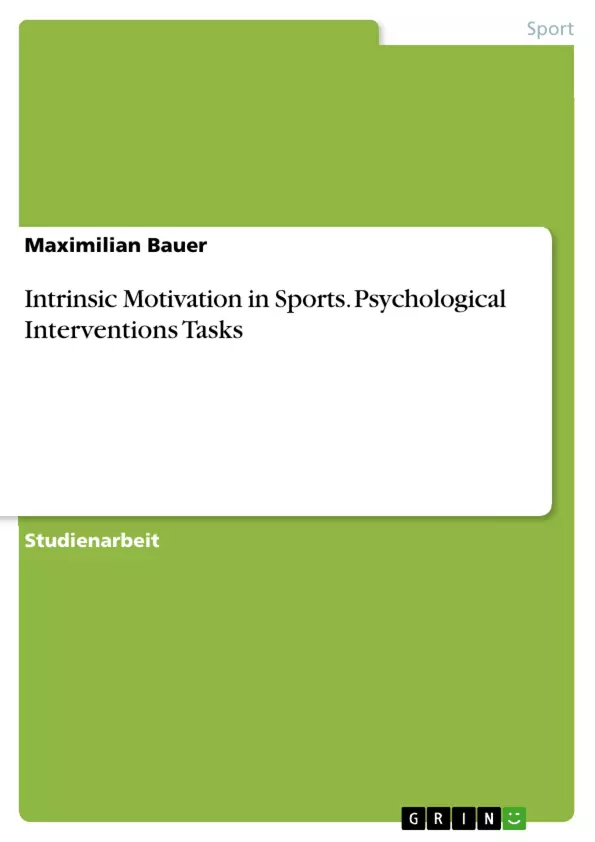Term paper about intrinsic motivation and its benefits for ahtletes. The paper compares a range of scientific articles about intrinsic motivation and point out the major advantages athletes can gain from achieving intrinsic levels of motivation in contrast to nonintrinsic motivation.
Intrinsic motivation is described as motivation that comes from the inside of an individual without any external influences (Cox, 2007). At the beginning of her golfing career Janet’s motivation is highly intrinsic as stated in the case study in lines 7 and 8. This changes due to different factors during her growing up process in life and her game to a form of extrinsic motivation as referred to later on in this paper. This is the main performance issue she has to deal with and the reasons for her motivational shift are going to be pointed out with help of Vallerand & Losier’s integrated theory of intrinsic and extrinsic motivation in sport (Cox, 2007).
Inhaltsverzeichnis
- Einleitung Teil A
- Vallerand & Losiers integrierte Theorie der intrinsischen und extrinsischen Motivation im Sport (Cox, 2007)
- Soziale Faktoren
- Psychologische Mediatoren
- Selbstbestimmungskontinuum
- Konsequenzen
- Literaturüberblick zur Motivation im Zusammenhang mit dem Fallbeispiel von Janet
- Einleitung Teil B
Zielsetzung und Themenschwerpunkte
Diese Arbeit analysiert die Motivationsveränderungen der Golferin Janet anhand des Fallbeispiels und der integrierten Theorie von Vallerand & Losier. Ziel ist es, die Ursachen für den Wandel von intrinsischer zu extrinsischer Motivation aufzuzeigen und mögliche Interventionsstrategien zu beleuchten.
- Intrinsische vs. extrinsische Motivation im Sport
- Einfluss sozialer Faktoren (Erfolg, Konkurrenz, Trainerverhalten)
- Rolle psychologischer Mediatoren (Kompetenz, Autonomie, Zugehörigkeit)
- Konsequenzen von Motivationsverlust
- Interventionsmöglichkeiten zur Förderung intrinsischer Motivation
Zusammenfassung der Kapitel
Einleitung Teil A: Dieser Abschnitt führt in die Thematik ein und stellt den Fall der Golferin Janet vor, deren anfänglich hohe intrinsische Motivation im Laufe der Zeit abnimmt. Es wird die Bedeutung intrinsischer Motivation im Sport hervorgehoben und die Anwendung der Theorie von Vallerand & Losier angekündigt, um die Ursachen für Janets Motivationswandel zu analysieren.
Vallerand & Losiers integrierte Theorie der intrinsischen und extrinsischen Motivation im Sport (Cox, 2007): Dieser Kapitelteil erläutert das Modell von Vallerand & Losier, das soziale Faktoren (Erfolg, Konkurrenz/Kooperation, Trainerverhalten), psychologische Mediatoren (Kompetenz, Autonomie, Zugehörigkeit) und die Konsequenzen von Motivationsveränderungen berücksichtigt. Die Analyse von Janets Fall wird anhand dieses Modells durchgeführt, wobei ihr anfänglicher Erfolg, die positive Teamdynamik mit ihren Freunden und das unterstützende Coaching ihres ersten Trainers im Kontrast zu den späteren Entwicklungen, die von Konkurrenzdenken und Druck geprägt sind, dargestellt werden.
Literaturüberblick zur Motivation im Zusammenhang mit dem Fallbeispiel von Janet: Dieser Abschnitt gibt einen kurzen Überblick über aktuelle Forschungsergebnisse zu Motivationsveränderungen im Sport, insbesondere zum Einfluss von Peer-Groups und Trainern auf die intrinsische Motivation junger Athleten. Es wird auf eine Studie von Jõesaar, Hein, und Hagger (2011) Bezug genommen, die den Zusammenhang zwischen motivationalem Klima und intrinsischer Motivation aufzeigt. Die Zusammenfassung deutet an, dass die Literatur mögliche Interventionsstrategien zur Aufrechterhaltung intrinsischer Motivation aufzeigt.
Schlüsselwörter
Intrinsische Motivation, extrinsische Motivation, Sportpsychologie, Vallerand & Losier Modell, soziale Faktoren, psychologische Mediatoren, Selbstbestimmung, Motivationswandel, Interventionsstrategien, Fallbeispiel, Jugend-Sport.
Häufig gestellte Fragen (FAQ) zur Analyse des Motivationswandels bei Golferin Janet
Was ist der Gegenstand dieser Arbeit?
Diese Arbeit analysiert den Motivationswandel der Golferin Janet von intrinsischer zu extrinsischer Motivation anhand des Fallbeispiels und der integrierten Theorie der intrinsischen und extrinsischen Motivation im Sport von Vallerand & Losier (Cox, 2007). Ziel ist es, die Ursachen für diesen Wandel aufzuzeigen und mögliche Interventionsstrategien zu beleuchten.
Welche Theorie wird angewendet?
Die Arbeit verwendet die integrierte Theorie der intrinsischen und extrinsischen Motivation im Sport von Vallerand & Losier (Cox, 2007). Dieses Modell berücksichtigt soziale Faktoren (Erfolg, Konkurrenz/Kooperation, Trainerverhalten), psychologische Mediatoren (Kompetenz, Autonomie, Zugehörigkeit) und die Konsequenzen von Motivationsveränderungen.
Welche sozialen und psychologischen Faktoren werden betrachtet?
Soziale Faktoren wie Erfolg, Konkurrenz, und das Verhalten des Trainers spielen eine Rolle, ebenso wie psychologische Mediatoren wie Kompetenz, Autonomie und Zugehörigkeit. Die Analyse untersucht, wie diese Faktoren den Motivationswandel bei Janet beeinflusst haben.
Welche Kapitel umfasst die Arbeit?
Die Arbeit gliedert sich in eine Einleitung (Teil A), die die Thematik und den Fall von Janet vorstellt. Es folgt eine detaillierte Erläuterung der Theorie von Vallerand & Losier, gefolgt von einem Literaturüberblick zu Motivationsveränderungen im Sport. Die Einleitung (Teil B) rundet die Arbeit ab.
Welche Rolle spielt die Literatur im Kontext der Arbeit?
Der Literaturüberblick beleuchtet aktuelle Forschungsergebnisse zu Motivationsveränderungen im Sport, insbesondere den Einfluss von Peer-Groups und Trainern auf die intrinsische Motivation junger Athleten. Es wird Bezug auf Studien (z.B. Jõesaar, Hein, & Hagger, 2011) genommen, die den Zusammenhang zwischen motivationalem Klima und intrinsischer Motivation aufzeigen.
Welche Schlüsselwörter beschreiben die Arbeit am besten?
Schlüsselwörter sind: Intrinsische Motivation, extrinsische Motivation, Sportpsychologie, Vallerand & Losier Modell, soziale Faktoren, psychologische Mediatoren, Selbstbestimmung, Motivationswandel, Interventionsstrategien, Fallbeispiel, Jugend-Sport.
Welche Schlussfolgerungen werden gezogen?
Die Arbeit zeigt auf, wie soziale und psychologische Faktoren den Motivationswandel bei Janet beeinflusst haben. Durch die Anwendung des Modells von Vallerand & Losier werden die Ursachen des Motivationsverlustes identifiziert und mögliche Interventionsstrategien zur Wiederherstellung intrinsischer Motivation vorgeschlagen. Der genaue Inhalt der Schlussfolgerungen ist jedoch nicht im Inhaltsverzeichnis explizit genannt.
- Arbeit zitieren
- Maximilian Bauer (Autor:in), 2013, Intrinsic Motivation in Sports. Psychological Interventions Tasks, München, GRIN Verlag, https://www.grin.com/document/313373



